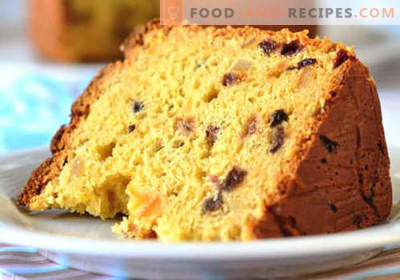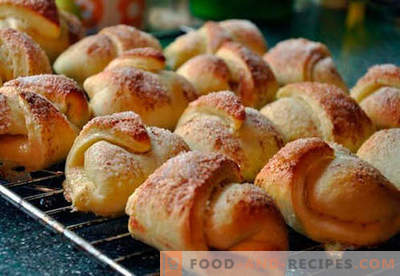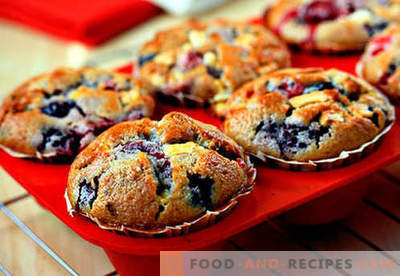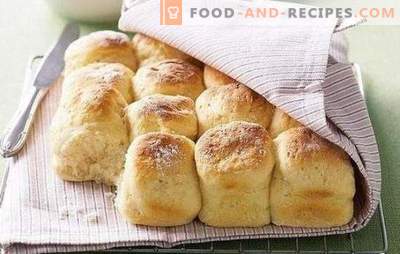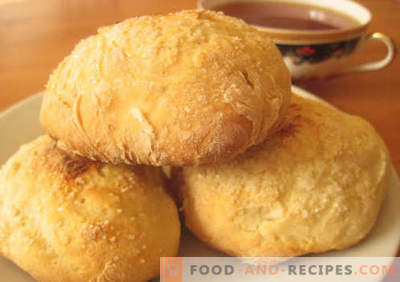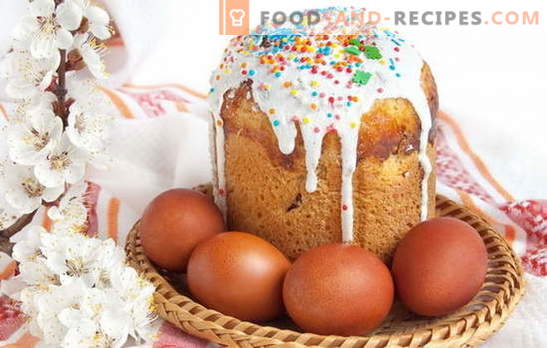
One may argue or argue about the benefits and harms of yeast fungus, but the point of reconciliation of supporters of the yeast and yeast-free method of making dough still need to recognize the fact that humanity lives in close proximity to the billions of microorganisms that inhabit not only the corners of our inaccessible to man the planet, but also the human body.
These inhabitants are not fully studied by microbiologists, but some of them have already been registered and recognized as “assistants” of people.
These include some types of yeast and lactic acid bacteria.
These invisible representatives of the terrestrial fauna, no matter how we try to isolate ourselves from their presence, enter into the food and into our organism their air.
Therefore, people, having ceased senseless resistance, took them into the service, which brought considerable success to the development of world cuisine, especially in such areas as winemaking, cheese making, and baking.
Easter cake on kefir without yeast - basic technological principles
There are several types of yeast-free pastry, which can quite successfully replace traditional yeast pastry.
It is not a secret to anyone that the bakedness of baking is achieved by raising the dough, which is provided by the yeast, which emits air bubbles, in the process of proofing. The emitted gas is a product of the vital activity of yeast, formed as a result of their nutrition with sugar and flour, which in turn contain carbohydrates, a nutrient medium for yeast.
What to do if, for some subjective or objective reasons, the hostess does not want to use yeast for making baked pastries?
Alternative to yeast - yeast on kefir.
To compare how the dough rises on yeast or kefir, you can probably. But in terms of the strength and intensity of the fermentation process, such a comparison would undoubtedly indicate a significant preponderance of yeast. Lactic acid bacteria, participating in the biological chain, like yeast, prefer to choose dairy products as their habitat. They work on the same principle as yeast, but less intensively. Even if the dough is prepared without the use of yeast, then fermented milk bacteria still need a warm environment, so kefir must be warm. It is possible (and even better!) To use fermented dairy drink, but without a trace of mold and bitterness. Practically from any fermented milk product, not eaten before the specified term, remarkable dough turns out. However, in order for dairy bacteria to lift the dough well, you need to add them a little more than yeast, and you also need more time to multiply in the milk medium. Sugar and flour additionally provide dairy microorganisms with energy.
To prepare the yeast on kefir will need from 24 to 76 hours. Not all housewives have enough time and patience for such a long process, although the use of sourdough for Easter cakes on kefir without yeast is the most effective way to make baking really festive.
The second option for making dough on kefir without yeast is using soda or other baking powder. The lactic medium in conjunction with alkaline, which is baking soda, causes a fast and vigorous process of release of gas bubbles, which, lingering between the fibers of the dough formed by fiber, ensures its rise. Using this method of kneading dough as the main one, you need to ensure that the amount of soda and acid is as balanced as possible. An excess of soda leads to the fact that its remains, which have not entered into reaction with lactic acid, make the dough and subsequently baking dark and unpleasant to the taste, heavy and settled.
To achieve the desired increase in the dough for cakes on kefir without yeast, combining the physical and biochemical properties of the products (eggs, butter and others) with the methods of their mechanical processing, for example, beating, during which egg white is converted into fibers, retaining air bubbles in the mass. In this case, you should deal with it as well as during the preparation of the sponge dough: mix the whipped mass with the other components of the dough carefully, taking care not to destroy the porous structure of the protein, and then immediately bake the products.
Recipe 1. Kulich on kefir without yeast
Ingredients:
Flour 450g
Kefir 300 ml
Eggs 3 pcs.
Soda 15 g
Vanillin 4g
Sugar 200 g
Orange: juice - 100 ml; peel - 30 g
Cognac 30 ml
Salt, fine
Oil (spread) 150 g
Raisin without seeds 200 g
Glaze 70 g
Powder 50 g
Preparation:
Kefir (20-25C), juice and half of the sifted flour with soda mix in a deep bowl. Cover tightly with foil and keep warm; bubbles must appear on the surface. Beat the eggs, gradually adding sugar: the mass should increase by 3 times, as for making biscuits. Add soft butter to the eggs, continuing beating, zest, brandy, vanillin. Combine the second half of the flour with the raisins washed and steamed in boiling water.
Combine gradually, adding to the dough first beaten egg-butter mixture, then - flour and raisins, one spoon each. It should be very soft and airy dough, almost liquid.
Spread it in equal parts into detachable forms for Easter cakes, or use disposable parchment forms that have been pre-greased. Immediately put the dough in a preheated oven (180C) and bake.
Cooled cakes covered with protein glaze, powder.
Recipe 2. Kulich on kefir without yeast, oil
Ingredients:
Kefir (1.0%) 100 ml
Sour cream, fatty 180 g
Oil 450 g
Flour 600 g
Soda 30-40 g
Vanilla 5g
Saffron 3 g
Rum 25 ml
Sugar 350 g
Candied (small cubes) 150 g
Eggs 4 pcs.
Cooking:
Separate the yolks, rub with sugar (150 g) and soft butter, add sour cream and kefir, saffron, vanilla (3 g) brewed and combined with rum. Mix soda with sifted flour, add a pinch of salt, finely chopped candied fruits. Combine the liquid and dry parts of the dough and mix well. Spread 200 g in cake muffins and bake until golden brown.
Finish the cakes grease whipped with sugar (200 g) proteins, pre-cooled. Add 2 g of vanillin to the protein mass before the end of beating. Decorate Easter cakes with candied chips.
Recipe 3. Sourdough for Easter cakes on kefir without yeast
For those who love lush baking, but at the same time avoids the use of yeast and too much baking, which makes yeast-free dough “elegant” - a recipe for kefir starter.
Products:
Kefir of any fat content 0.5 l
Sugar 100 g
Flour 300 g
Preparation:
Pour the kefir into a larger jar so that there is free space for the products to be added and for the fermentation process when the leaven starts to rise. Add sugar and stir well to dissolve. Add the specified amount of flour gradually, dividing it into 2-3 parts, with an interval of 10-12 hours. All this time, the sourdough should be covered with gauze and close to the heat source. When the sourdough rises and acquires the characteristic sour smell, take half of it to make the dough, and store the rest at + 3-5C, adding kefir and flour once a week. The leaven consistency should be similar to pancake batter.
Recipe 4. Kulich on kefir without yeast, on sourdough
Ingredients:
Sourdough 300 ml
Sparkling water, table 200 ml
Sugar 250 g
Vanilla extract 5 mg
Saffron 3 g
Salt
White flour 800 g
Cottage cheese (18%) 400 g
Eggs 5 pcs.
Raisin 200 g
Oil 100 g
Soda 50 g
Preparation:
Oil smash with sugar, gradually adding eggs. Combine the mass with the curd, continuing to whip. Add brewed saffron, vanilla extract.
Sift flour and, combining it with salt and soda, add to the prepared mixture. Add steamed and slightly dried raisins here. Stir the dough, gradually pouring the leaven, combined with sparkling water, until a homogeneous consistency, which should be like thick cream.
Spread cooked dough into forms, not more than 200 g per serving. Forms must first be plentifully greased with oil (vegetable) or sent with oiled parchment. Place the forms on a pan or baking sheet, covering the dough on top with an airtight material. Soak the blanks in this form for about a quarter of an hour and immediately send them to a preheated oven. Check the readiness of the dough for cakes with the help of
Recipe 5. Small cakes on kefir without yeast
Ingredients:
Flour 100 g
Eggs 3 pcs.
Semolina 200 g
Kefir 150 ml
Spread 140 g
Sugar 250 g
Baking Powder 35 g
Dried fruits 300 g
Orange Juice 100 ml
Flavors of choice
Cooking:
Separate egg whites and yolks. Protein temporarily cleaned to cool. Leave half the sugar to make a glaze. After cooling, whip proteins into foam, gradually adding sugar, or replace it with the same amount of powder.
Mix semolina, flour, baking powder. Add a little salt and vanilla powder to the dry mixture, if you want to add flavor to baking. Beat yolks with sugar and spread. You can replace the spread with any butter, vegetable or cream. To the oil mixture add kefir, heated to room temperature and combined with the juice prepared from fresh orange.
In the liquid mixture, gradually add the dry ingredients, prepared dried fruits (or candied fruits), and knead the thin dough. Pour into small cupcakes and bake at 180C for 20 minutes. When the product is cool, remove from the mold and grease the surface with icing.
Recipe 6. Honey and nut cake on kefir without yeast
Ingredient list:
Eggs, large 6 pcs.
Honey, lime or buckwheat 400 g
Boiling water 200 ml
Mint (fresh or dried leaves) 20-30 g
Linden (flowers) 50 g
Butter, butter or margarine 200 g
Kefir 350 ml
Flour 400 g
Soda 30g
Powdered sugar 100 g
Nuts shredded (cashews, peanuts, almonds) 250 g
Vanilla 4 g
Cooking:
In 200 ml of boiling water, brew crushed grass, strain the infusion and warm with honey to make a thick syrup. Add 3 eggs and 3 egg yolks to it. Beat the mass in a deep bowl until doubled. Pour kefir and melted butter into the mass. Mix the sifted flour and nut chips, soda and half of vanilla powder. Add a pinch of fine salt. In the liquid part of the dough, gradually add the flour mixture. It should make the consistency of the dough like pancakes.
Spread the dough into small, preformed cylindrical shapes, filling them just above the middle of the height. Bake on the middle shelf of the oven. You can check the readiness with the help of a wooden skewer or by pressing on the “cap”: it must be elastic.
Recipe 7. Kulich on kefir without yeast from two-layer dough
Ingredients:
Cottage cheese 400 g
Cherry, dried 200 g
Semolina 150g
Cherry liqueur 100 ml
Condensed milk (8%) 400 ml
Eggs 4 pcs. + 3 yolks
Kefir 250 ml
Raisin 200 g
Baking Powder 10 g
Flour 300 g
“Amaretto” 50 ml
Oil 200 g
Soda 25 g
Vanilla powder 8 g
Salt 15 g
Cocoa 50 g
Sugar 250 g
For glaze:
Icing Sugar 150g
Protein 3 pcs.
Vanilla 4 g
Cooking:
Put the fat cottage cheese in the bowl of a blender or combine. Pour in the cherry liqueur and condensed milk, add 3 whole eggs. Smash the mixture to a smooth and fluffy consistency and add 100 g of softened butter, without stopping the beating. Put the dried cherries in the whipped mass, after sorting and washing them.
Add 4 g of vanilla, salt (half of the amount taken) and baking powder to the semolina. Add the dry mixture gradually to the whipped mass, mix thoroughly and leave for a while: you need to wait until the semolina swells.
Prepare rigid cylindrical forms for Easter cakes (it is better to take detachable ones). Grease them and, dividing the dough made from flour and cottage cheese, spread them into forms. Place the forms in a pan with a high side, tilted so that the dough flows from the bottom to the edge of the form, not reaching 2-3 cm. After baking, a diagonal line should form between the two layers of Easter cakes.
Put the pan gently in a preheated oven for 15 minutes, add boiling water to it and bake the curd dough for a couple until the water evaporates. As soon as the dough becomes thick and brewed, remove the pan with the forms from the oven. Do not remove the molds from the pan, let them cool. Then put the form straight and pour the dough on kefir, with cocoa powder.
For the preparation of dark dough, combine the sifted cocoa, flour, soda, the second part of salt and vanilla powder. Pour the prepared raisins into the flour.
Beat eggs with sugar, add soft butter, kefir and “Amaretto”. Combine dry and liquid mixture, mix. Fill the forms with the curd dough with the prepared mass and return them to the hot oven. Bake at 180C. Check the readiness of cakes with a wooden stick. Cool and remove from the molds. Garnish with protein cream, whipping chilled proteins with powder and adding vanillin.
Kulich on kefir - tips and tricks
- In order to make pastry made from yeast-free dough not to dry out for a long time and retain its freshness, try to add butter to the dough, which, due to its properties, retains moisture in flour products. With the same purpose, you can mix the flour with a small amount of starch.
- If you make dough using cocoa, then you need to consider that it absorbs moisture more than flour. Therefore, it is better for chocolate dough to add more moist ingredients and be sure to mix in the butter to create a soft chocolate texture of the finished baking.
- Considering that the moisture content of the flour may not be the same, because it depends on many factors, be more attentive to the amount indicated in the recipe: in almost all cases it is necessary to adjust its weight.
- It would be better if the consistency of the dough (necessary density) will be achieved due to its kneading, and not an increase in the amount of flour. Remember that the formation of its fibers and the saturation of the dough with air depend on the duration of mixing.

